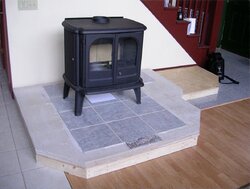I've been looking at big top-loaders and the required floor protection sure does vary. Some manufacturers just require a non-combustible floor while others want an very expensive insulated construction. The Quadra-Fire Isle Royale interests me, but as I read the manual it seems to need a very thick hearth pad. Anyone got any words of wisdom to offer on floor protection?
Thanks, Scotty
Thanks, Scotty



